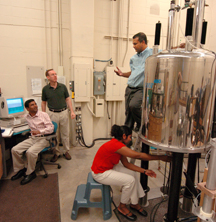Purdue-IU researchers explore new method for early disease diagnosis
2007-07-24
Purdue University researchers worked with the Indiana University School of Medicine to establish a technique that provides a new approach for detecting a number of genetic disorders found in infants and young children.
Daniel Raftery, a Purdue professor of analytical and physical chemistry, and his collaborators used a simple chemical reaction to improve the ability to detect important molecules in complex fluids like blood and urine. The technique makes the markers for some genetically caused metabolic disorders up to 100 times more visible, Raftery said.
"This technique allows us to profile a class of biomarkers - molecules that indicate disease - that would otherwise be very difficult to detect," he said. "The increased sensitivity could allow doctors to diagnose a range of diseases at very early stages. We examined genetically based metabolic disorders, or inborn errors of metabolism, because it is especially important that they be treated early in a child's life in order to prevent tragic effects such as brain damage. The technique also could catch borderline cases that may have otherwise gone undiagnosed until serious symptoms arose."
Bryan Hainline, director of the clinical division of the Department of Medical and Molecular Genetics and clinical associate professor in the metabolism division of the Department of Pediatrics at Indiana University School of Medicine, provided access to clinical samples and insight into the markers of metabolic disorders. The IU team was critical to the success of this work, Raftery said.
"The combination of Purdue's research strength in chemistry and the IU School of Medicine team's knowledge of pediatric metabolic disorders allowed us to quickly advance this tech

Analysis performance using
nuclear magnetic resonance
spectroscopy equipment